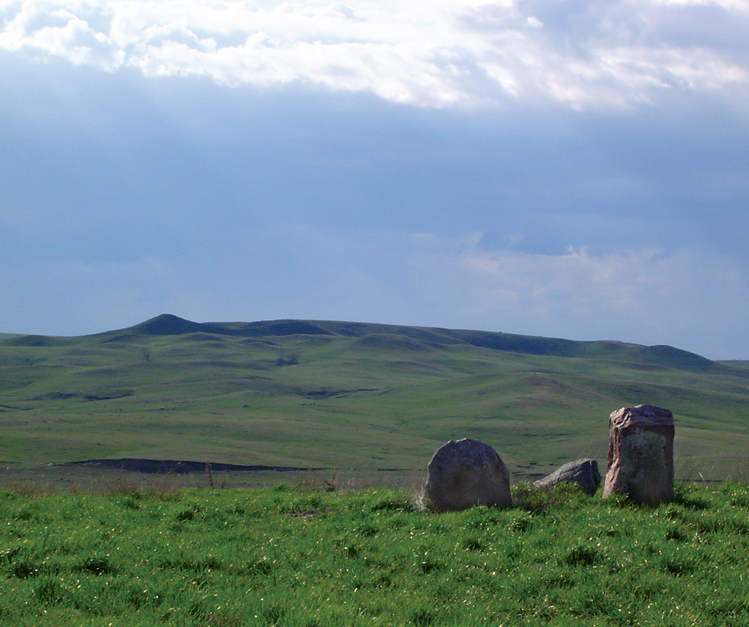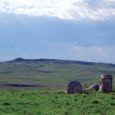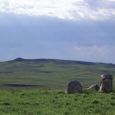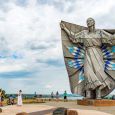The Gift of South Dakota
Subscriptions to South Dakota Magazine make great gifts!
Subscribe today — 1 year (6 issues) is just $29!
Pollock’s Stone Idols
Feb 7, 2018
 |
| Three stones on the Campbell County prairie could be the source of a centuries-old Arikara legend. |
Three seemingly ordinary stones sit on a hill above some cabins at the Oahe Sunset Lodge on Lake Pocasse, just west of Pollock. Some believe these stones are the subject of an Arikara legend — concerning a pair of star-crossed lovers and their dog — reported in the journals of the Lewis and Clark Expedition.
To find the stones, take Highway 1804 north and turn left at the sign for the Oahe Sunset. The stones are on a small hill to the right, just past the cabins. Though some have described them as "boulders," they're not all that imposing — small enough that a Strongman contestant or a Bobcat could lift them. Are these the stones of legend?
That may be impossible to know.
We do know that on October 10, 1804, the Corps of Discovery happened upon an Arikara village near the Missouri River. Three days later the journals relayed an ostensible Arikara legend about three stones near a creek they called Stone Idol Creek, now known as Spring Creek.
Clark described a stone trio "resembling humane persons & one resembling a Dog … situated on the open Prairie," to which the "Rickores pay Great Reverance [and] make offerings."
The story — as retold by nearby Mound City native, historian, South Dakota state representative and gubernatorial candidate Alice Kundert — concerned a pair of young lovers forbidden to marry by the young woman's father, a chief. "When the youth persisted in his attention, his weapons were taken from him and he was driven out onto the prairie to starve or freeze in the winter cold. The Indian maiden resolved to die with her lover and so slipped away unnoticed from her father's lodge. Close behind the two lovers followed the young brave's dog."
Winter passed. The chief was out riding one spring morning when he "came upon a startling sight."
"There side by side stood the two young lovers … Their faces and forms showed young and strong with neither signs of gaunt hunger or suffering upon them. Close beside them stood the faithful dog. The Great Spirit had pitied the plight of these young children and of the prairie and turned them into stone images. About them he had placed an abundance of food, and clusters of wild grapes hung in festoons from a tree above the stone images, with one purple cluster reaching down to touch the maiden's outstretched hand."
Was this a real Arikara story?
"It sounds very plausible," says Jasper Young Bear, a co-founder of the Medicine Lodge Confederacy, an organization — concerned with preserving "the Arikara culture, language, health and sustainable lifestyle" on the Fort Berthold Indian Reservation in North Dakota.
"That motif — that a person has been turned to stone because of heartache — is the same type of story that was told about the woman that Standing Rock was named after. Right out in front of the Standing Rock tribal headquarters in Fort Yates, there's the actual rock — on a pedestal, moved from its original place — named after an Arikara woman that was turned to stone by the powers above because she was broken-hearted.
"Stones in Arikara culture are considered animated objects. A rock is the symbol of the will of God. Over and over — you will hear this, you will see this, you will dream this.
"The rocks are actually people anyway. You're not turning into some inanimate object. The word we gave to the Mandan people is a high term of respect — the Arikara word for Mandan is "kunit," which literally means "rocks." The [Arikara] considered the Mandan a powerful, knowledgeable people that stood for the will of God.
"A big part of this [rock] motif that continually reoccurs within our stories is that they have power, and that this power is connected to the thunder and lightning. There's a [longstanding] ideology regarding the thunder and lightning, and the wind and the rain as Gods that sit in the West, and that these powers, visible on earth, were born from the power of the rocks. In the beginning of our creation story, the Creator himself squeezed a rock and from it gave birth to these four Gods that sit and protect the Evening Star, which is the mother of our people."
The Arikara people have a long history in present day South Dakota. Archaeologist William Strong suggested that pottery fragments found at the Arzberger archaeological site — a fortified village near Pierre, occupied in the 13th and 14th centuries — showed "a general resemblance to historic and protohistoric Arikara wares." Surveys at the Vanderbilt site show that during that era indigenous earth lodge villages existed in the Missouri River Valley in what is now Campbell County.
Even before the Lewis and Clark expedition, European traders had brought a series of devastating smallpox epidemics to the Middle Missouri Valley and disrupted the Arikara role in the continental indigenous trade network.
"The Arikara's hatred of Americans had several roots," wrote historian William R. Nester in The Arikara War. "The most important was the succession of trading expeditions up the Missouri, which threatened the Arikara position as one of the region's trade middlemen. The animosity was inflamed by the death by smallpox of one of their chiefs during a visit to Washington in 1806."
Less than 20 years after the Corps of Discovery were regaled with the story behind the stones, the amity between the Arikara and the Euro-American newcomers had dissolved.
In 1823, Arikara warriors struck a fur-trading party. The U.S. Army responded by bombarding their villages with artillery. The conflict — which became known as the Arikara War — was the first between the U.S. military and the indigenous people of the Plains.
Though the roots of the conflict went back further, Arikara animus towards these particular trappers began in 1822, when a Rocky Mountain Fur Company expedition led by William Ashley and Andrew Henry set out to trap pelts in the Rockies and transport them east rather than trade with Indians for them. That fall the expedition stopped at the Arikara villages on the Missouri River to trade for horses, and promised to set up a trading post there the following spring. The company reneged on their promise, angering the Arikara.
When Ashley and a party of around 100 trappers returned the following year to trade horses again, tensions were already high. A couple months earlier an Arikara war party had traveled downriver to what later became known as American Island, near Chamberlain, and attacked Fort Cedar — a post where the Missouri Fur Company traded with the Dakota/Lakota. The raid was successful but Grey Eyes, an Arikara chief, lost his son in the battle.
When Ashley's party disembarked at the village, Grey Eyes demanded reparations for the loss of his son. Ashley managed to defuse the situation by explaining that Fort Cedar belonged to another outfit, and the two parties agreed to trade horses the following morning. Ashley acquired 19 horses in exchange for muskets, ammunition and other goods, and resolved to leave the following day, but wasn't able. Stranded by a storm, the party was forced to hold off for another day.
That afternoon, according to Ashley's journals, two upper village chiefs named Bear and Little Soldier warned him that some lower village chiefs were planning to attack. Then later that night, a trapper named Aaron Stephens slipped into the village, reportedly looking for "female companionship." Whatever he did, he didn't live through the night. A man named Edward Rose ran towards the keelboats, followed by an Arikara war party of several hundred, to tell Ashley that Stephens had been killed. Near dawn, the war party attacked the trapper camp on the shore, killing 12 men.
The surviving men fled to the keelboats and then to a nearby island, where they buried two of their dead. One of these boats features in South Dakota lore as the scene of a solemn prayer by famous frontiersman Jedediah Smith, the "gentleman trapper" who was said to pack a burner and a bible. According to Dale L. Morgan's Jedediah Smith and the Opening of the West, the trapper/ordained minister "stepped forward, and while the men stood silent around, with bowed head he prayed to that God in whose sternness all were prepared to believe, in whose compassion at this moment they much needed to believe." This devotional moment is enshrined in the State Capitol in a mural — The Peace that Passes Understanding — by artist Charles Holloway.
That August, a combined force of Army soldiers led by Lieutenant Colonel Henry Leavenworth — along with Ashley's trappers, a Missouri Fur Company militia and Dakota/Lakota allies — marched on the Arikara villages, bombarding them with artillery. Grey Eyes and perhaps 50 others were killed. Then Leavenworth surprised everyone by agreeing to a ceasefire, which didn't satisfy the fur traders. When the Arikara abandoned their villages for fear of reprisals, members of the Missouri Fur Company party burnt them to the ground. This began the long Arikara flight that ended at the Fort Berthold Reservation, established in 1870 for the three-affiliated tribes — the Arikara, Mandan and Hidatsa. The legend has since lingered around the banks of Stone Idol Creek, but any certain knowledge as to the identity of the sacred stones left with them.
The stones at the Oahe Sunset Lodge were actually moved, from a place closer to the creek to their present spot, by previous lodge owner Denny Jensen.
Jensen may have sincerely believed he had found the same stones Lewis and Clark reported seeing. Assistant State Archaeologist Mike Fosha visited the site in 2000 and concluded that the owner was likely in the general vicinity of the site but that "Stone Idol Creek is several miles long and any location along this stretch has equal probability for the location." Some local papers ran with that, presenting Fosha's visit as a certificate of authenticity, prompting him to respond in the South Dakota Archaeological Society Newsletter that, "next time I will just nod my head and say nice rocks."
In a 2004 SDAS Newsletter article, archaeologist Linea Sundstrom posited two possible locations for the stones — Spring Creek near Pollock, and Porcupine Creek near Fort Yates. "Lewis and Clark noted the stone idols … when the explorers were somewhere between the mouth of the Grand River (October 8) and the Cannonball River (October 18); thus, either of these locations could be correct," though "the more likely of the two locations for the stone idols is present-day Spring Creek."
Sundstrom contextualized the stones within a diverse Native American tradition of stone person stories among various tribes throughout the region. Native American scholar Vine Deloria Jr. wrote an entire chapter on "Sacred Stones and Places" in his last book, The World We Used to Live In. "One of the most prevalent entities in the traditional Indian spiritual universe," wrote Deloria, "was the sacred stone."
Sundstrom also noted that, "Most of the historical accounts describe offerings piled at the feet of the stone persons."
"[Making offerings] is a relation to a natural, or in this case a semi-unnatural event, regarding power," says Jasper Young Bear. “There's an idea that there's luck and power around that area. So what the Indians are doing is they're creating a transference and counter-transference, to allow that sacredness to seep into their lives by acknowledging the Great Mystery."
"This [giving of offerings] shows up archaeologically," says Fosha, "at the base of stone features that are unique in the landscape." Unsurprisingly, since the stones had been moved, no evidence of offerings was found where Denny Jensen placed the stones he found with a backhoe.
Maybe one day the SDAS will take a call from someone who's found three unusual stones near Spring Creek, and find evidence of offerings at their feet. Or maybe an offering site will be found minus the stones, perhaps because they've been moved by water or a backhoe. Maybe there are people who know — but aren't telling or haven't been asked — exactly which stones are the story's home. The story itself isn't stoneless.
Michael Zimny is the social media engagement specialist for South Dakota Public Broadcasting in Vermillion. He blogs for SDPB and contributes arts columns to the South Dakota Magazine website.










Comments